We have put together this guide so you can easily estimate how much it costs to remove a palm tree from your yard. The prices are based on what a local tree service company is likely to charge.
The average cost of palm tree removal is $240. The real range is $150 to $2,500. At the lower end, you have Alexandra palms for $150 and at the high end are Canary Island Date Palms that will cost $2,500.
Price varies greatly depending on the palm species, its location on your property and difficulty to remove.
Below we look at all palm species and their sizes. Get more accurate pricing figures below.
| National Average Palm Removal | $285 |
|---|---|
| Typical Range | $200 - $450 |
| Low End - High End | $150 - $2,500 |
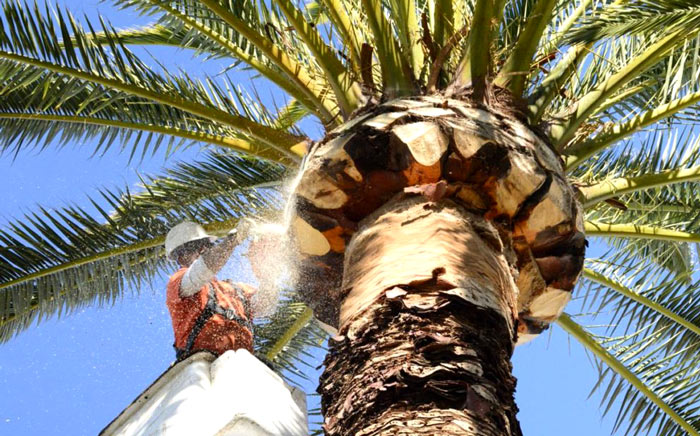
Table of contents
ToggleCost to remove palm trees by size
The below price by size estimates are based on the most common palm trees being removed from Australian gardens and yards these days, which is the Cocos palm. This palm has a trunk between 30-40cm in diameter and a height of 5 – 8m.
They were very trendy in the 70’s and 80’s, but since then people’s styles have changed so the Cocos palms have got to go!
Small palm removal cost – 1 story high (5m or 15ft) high.
Like all tree removals, the location of the tree is going to govern the price. If the palm is in your front yard and there is plenty of space to fell the tree, it will be a quick job and should cost you around $150 – $200.
If the tree is out the back next to a pool, for example, the palm tree will need to be climbed and taken down piece by price, then carried by hand to the truck on the street.
Something like this will cost closer to $300.
Medium palm removal cost – 1-2 stories high (5 – 8m or 15 – 24ft)
Without going into too much detail about access and how it affects the price, something with easy access and plenty of room to move will cost $250 -$350.
Something in a tighter spot and little room to work, will be closer to $450.
Large palm tree removal cost – 2-3 stories high (8 – 12m or 24 – 36ft)
For a Cocas palm 8 – 12m is quite large, so it is more likely you have either a cotton palm or a canary island date palm. They are priced a little different from Cocos Palms, but there is a specific section below.
If it is a plan with a truck about 30cm in diameter and a height of 2-3 stories you at look at $500 – $600.
| Palm tree size | Height | Low | High |
|---|---|---|---|
| Small | 5m | $150 | $300 |
| Medium | 8m | $350 | $875 |
| Large | 12m | $520 | $1,290 |
| Extra Large | 20m | $900 | $2,500 |
Learn how to save an average of 40% off the price of palm removal The above prices include removal. We have put together a special guide on ways to save on palm tree removal. You can see a summary of that guide below.
Palm tree removal prices by type/ species
| Palm Species | Average | Low | High |
|---|---|---|---|
| Cocos Palm | $300 | $250 | $350 |
| Australian Cotton Palm | $827 | $600 | $1,200 |
| Canary Island Date Palm | $1,660 | $1,200 | $2,400 |
| Cabbage Palm | $725 | $500 | $900 |
| Alexander Palm | $205 | $150 | $300 |
| Foxtail Palm | $950 | $650 | $1,100 |
| Bangalow Palm | $205 | $150 | $300 |
Cocos Palm Removal Cost (Queen palm)
Botanical name: Syagrus romanzoffiana
We used the Cocos palm in the above breakdown of palm removal prices by size. The average price for cocos palm removal will be $350 – $750. Scroll to the top to see prices. This palm was used as the most common one removed these days.
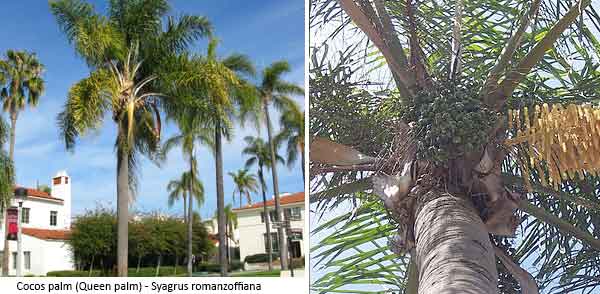
Australian Cotton palm tree removal cost
Botanical name: Washingtonia filifera
This can be quite a beautiful tree when it is pruned on a regular basis. For an arborist though, they are a nightmare to prune or remove. The reason is the razor-sharp spines that are all over each frons.
It’s hard to price as again it will depend on how accessible it is, but you can expect to pay from $600 – $1200.
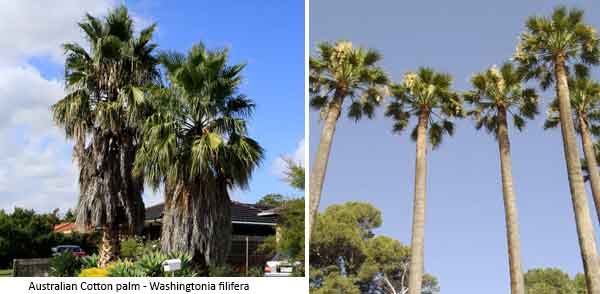
Canary island date palm/ Phoenix palm removal
Botanical name: Phoenix canariensis
This is the biggest and most expensive palm to have removed. The trunk can get up to 1.5 meters wide and can have up to 50 fronts, all with 12-inch needles with venom-coated tips. In short, they are not fun to remove or prune, so you will be charged a hefty price.
Something 1 story high (5m) will set you back $1200 – $2400. Double the height will not necessarily mean double the cost. It will probably increase it by a factor of 1.5.
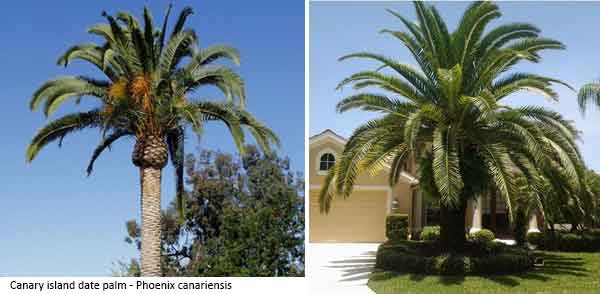
Australian Cabbage palm (Sabal palm) removal
Botanical name: Sabal palmetto
The cabbage palm although not as large as the Canary Island Date palm, is loathed just as much by arborists to prune or remove. This is thanks to the razor-sharp teeth on every front. This is not so much heavy work as it is delicate and slow going to avoid being stabbed by the thorns.
In some cases when the tree has some age to it, the trunks are smooth in which case a cabbage palm removal is quite easy. It will cost between $500 – $900. But if they are covered in thorny spines, expect to pay more.
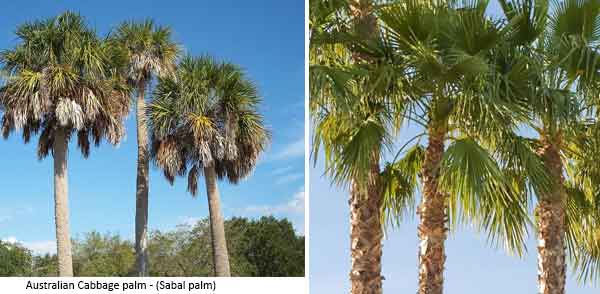
Alexandra palm tree removal
Botanical name: Archontophoenix alexandrae
This is a great palm to work on. It’s also dirt cheap. The trunks are generally quite thin (but do taper a little larger at the bottom). The removal of an Alexander palm around 1 story should cost you about $150. Two stories high, around $300.
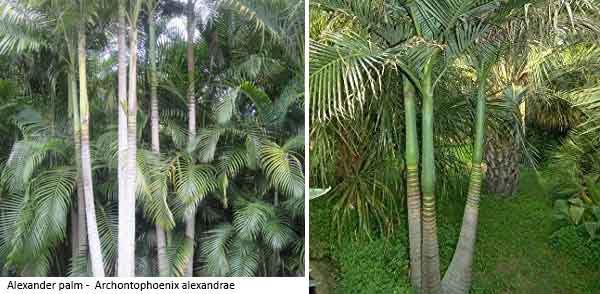
Golden Cane Palm Removal
Botanical name: Dypsis lutescens
Golden cane palms are tricky to price as they normally grow in clumps. So for this example, we are going to assume you have a clump of 3 palms. The average price for removal would be $352 with the low end being $200 and the high end being $720.
Foxtail Palms
Botanical name: Wodyetia bifurcata
Foxtail palms are very expensive to remove because their sap is very acidic and great care needs to be taken when working on them. Once removed the chainsaws used need to be pulled apart and cleaned as the acid can corrode the chainsaw’s metal parts. An average 7m Foxtail palm will cost $650 to remove whereas larger ones with a bigger base may cost $1,100 or more.
Bangalow Palm
Botanical name: Archontophoenix cunninghamiana
Bangalow palms are much like Alexander palms in shape and size so their price to remove is going to be similar. The average cost of removal is $205, with the low being $150 and the high being $250.
Palm tree removal cost by city
| City | State | +/- Average | Avg. Cost |
|---|---|---|---|
| Sydney | NSW | + 9.06 % | $261 |
| Newcastle | NSW | + 3.74 % | $249 |
| Perth | WA | + 1.16 % | $242 |
| Brisbane | QLD | + 0.1 % | $240 |
| Canberra | ACT | 0 % | $240 |
| Gold Coast | QLD | – 1.23 % | $235 |
| Melbourne | VIC | – 2.17 % | $230 |
| Adelaide | SA | – 6.72 % | $220 |
Palm removal cost factors
Size of the palm
Obviously, this is one of the main factors. Height is actually easy to deal with, it’s the girth of the trunk that will cost you money. You will notice with the above palms, the larger the trunk, the exponentially more expensive the palm is to remove.
Accessibility & location
Access is a big factor when determining the cost to remove a palm tree. Having your palm in the front yard as opposed to being situated at the rear can actually save you 50%. The reason is it takes a lot more time and manpower to move the tree by hand to the truck out the front. If you have great rear access then this should not be a problem.
If the tree is in a garden with lots of space around to fell the tree and cut it up, it’s a faster job and will be much cheaper. If it is in a hard to get to spot like in a pool area and the tree must be climbed and blocked down piece by piece, then it will cost you more.
Number of trees
With each extra tree, it is not as simple as just multiplying the above figures. They become a lot cheaper in bulk. This is something you are best getting a quote on and is a little hard to calculate due to the above factors. You can try the tree removal calculator above which will give you a fairly accurate quote.
Stump removal
The above prices do not include the stump. Palms are quoted soft through, so it is not going to cost you much to get the stump removed. About $50 each should cover it. (This is for a stump 30-40cm) for larger stumps, please see our stump removal cost guide.
For more details on pricing for removing stumps check out our stump removal cost guide here.
Dumping fees
Roughly half the cost of palm tree removal cost is tied up in dumping fees. Waste disposal sites charge a fortune for rubbish to be dumped and it’s no different for green waste. With regular trees, your arborist can put them through their mulching machine and generate mulch that they can usually dump for free. Palm trees are different. They have a sap that is extremely acidic. So even if they were put through the mulching machine, the by-product would be useless to place in anyone’s garden as it would kill your plants.
If you can avoid dumping fees by disposing of the palm trees yourself, you will save hundreds. Below we have outlined how to go about that.
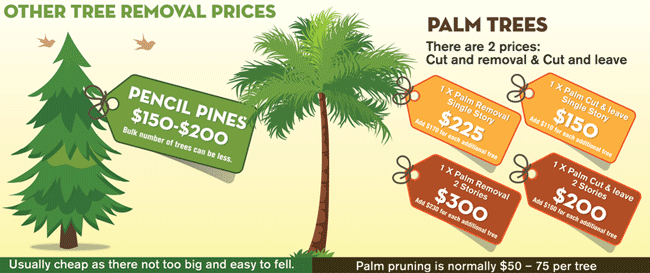
How to save on palm tree removal
We actually put together a more comprehensive guide on how to save on palm tree removal which not only mentions palm trees but other general ways.
Save on dumping fees
As mentioned above, dumping fees are the biggest cost when removing palm trees. With most waste disposal places charging upwards of $200 per tonne, it’s not difficult to save money by removing the waste yourself.
Where to dispose of for free
To take advantage of cheap or even free disposal, I suggest you get two prices from your tree removal services company when they come out to quote your job. Get one price for the complete removal of the palms and another price to fell them and cut them up into manageable-sized pieces. That way you have a guide on how much you can potentially save by removing the waste yourself.
Let’s look at the cheap method first, then the free ones.
Hire a skip bin or dumpster
If you have 5 palm trees or more to be removed (or one larger canary island date palm or phoenix palm) then you might be better off getting a skip bin delivered and having the tree cutting service dump in there rather than letting them dispose of the waste.
The reason is they would be paying retail prices to dump, and you would be paying wholesale through the skip hire place. They always have massive discounts on dumping fees at waste disposal places. In most cases, it will be cheaper to get them to haul away your green waste rather than your tree service company paying/charging retail.
Again you will need to get two prices from the arborist to make sure it is going to be worthwhile.
Green waste bin
Everyone has a green waste bin that they can fill to the brim with each collection and it gets hauled away for free. There is no real trick or mystery to this one, just get them to fell the trees and cut them into manageable size pieces for you to dispose of in your green waste bin over time. The amount you save will be worth the effort.
As palm trees are full of water, once cut down, they dry out extremely quickly reducing the weight of the tree by 1/3. This is going to make light work of the disposal process.
To get rid of it even quicker, why not speak to your neighbors and fill and free spaces in their bins also.
Council collections
I have saved the best for last. All local councils and counties have a scheduled date that allows residents to dump unwanted waste out the front of their homes to be collected free of charge by the council. This includes green waste.
To take full advantage of this, plan your palm remove a week before the clean-up and have the tree services company pile the waste on the front sidewalk for collection.
You will note I said 1 week and not 2 days. This will allow you a bit of a buffer just in case the tree company gets held up because of workload or weather.
Hire in the off season
When getting any tree trimming work done by a professional arborist, it is worth remembering that the high season is spring and summer. If you contract a tree surgeon in these months you are bound to be paying up to double what you would in the offseason. Tradesmen quote jobs depending on how much work they have on. If they are going through a lean period, they are likely to give you a cheaper price to win the work and get them through the winter.
FAQ's
Most palm trees are worthless in the secondary market. If you are looking to remove your palm tree, there is a slim chance you will be able to sell it. There are some palm trees that are desirable such as Date Palms and Phoenix Palms which landscape companies will pay you for to then come out and remove. They will then sell on for a profit.
You should always get a minimum of 3 quotes from local tree services before deciding on a contractor to remove your palm trees. There is a large difference in the price tree services charge for palm tree removal, so waiting to get all 3 quotes before making a decision could save you hundreds of dollars.
Yes, palm trees are generally easy to remove. If there is plenty of room to work at the base of a palm, then they are relatively easy to remove. Having just one single trunk and some small leaves at the top make them quite and easy to handle for any trained arborist.
However, I do not recommend you attempting to remove a palm tree yourself without the proper training. Chainsaws are extremely dangerous tools and using one from at heights makes it twice as dangerous. Call a local tree service to do the job for you.
In most cases, home owners insurance will not cover the removal of any tree. The only instances where they will come to the party and foot the bill is when the tree has fallen over in a storm or any other act of nature. Considering palm trees are all but hurricane proof, it is extremely unlikely they would fall over in a stiff wind. This means you will need to pay yourself to have them removed.
You can hand your palm tree transplanted. As they have a shallow root system they are relatively easy to dig out and transplant if you have the right machinery. I do not suggest you trying this yourself with hand tools. It is something left to professionals.
In general it is cheaper to cut down trees in winter. The main reason is not because the tree has less leaves and it’s easier to work on, it’s because the economy of supply and demand are in your favour.
Tree services along with landscapers and lawn care companies are in low demand in winter. If you have the same supply of companies in winter, but half the work to go around, companies become more competitive on price as they try to win what little work there is. You will save an average of 25% hiring in winter.
In most cases no. Tree services will come and cut down your palm tree for a fee, but the odds of you selling your tree are slim. If your tree is a desirable palm species such as a Date palm, you might be able to sell it to a local landscaping company who will then sell it on for a profit.
Not really. There are cases where home insurance will cover the cost of palm tree removal, but generally, it is following a storm when the tree has fallen or napped at the trunk. Some landscape companies will remove a tree for free. IF it is a desirable palm species, but in general you will need to pay for tree removal.
There are a few things you need to look for when selecting a tree service to remove your tree. Firstly when doing an internet search you need to have a look at their reviews. If they have too many 1 and 2 star reviews, you need to keep looking.
Next you need to do a background check. Go to ABN lookup and type in their company name. Have a look to see how long they have been in business and whether they have changed their trading name recently. When they are out quoting your job you need to ask for an arborist certificate and insurance details.
Trees are very difficult to price from a picture or a description over the phone. The reason is the difficulty and time take to remove a tree can only be assessed when taking into account the access to the property, obstacles around the tree and the shape and size of the tree itself. All of which is difficult to describe over the phone. Tree services will need to book in a time to view the job to give you a firm quote.
If your tree is protected due to its size will need to apply for a permit to remove the tree. To know whether your tree is protected, please refer to your local Tree Removal Ordinance for more information. In most cases palm trees can be removed without a permit as they are not native so councils do not protect them.
If the council feels you do not have sufficient grounds to remove the tree they may decide that it should stay. You can then get an arborist report from an independent arborist. If the arborist inspection finds the tree is dangerous, you can then resubmit your application for review. If the tree is protected and healthy, the likelihood of getting approval for removal is slim.
Most of the time, you will only need to give the tree company access to your yard to do the job. You will not need to be present while the tree is being removed. Arrangements can be made for payment after you have returned home and inspected the finished job.
Stump removal is normally priced separately. If you have a quote for a tree to be removed, make sure they have specify whether that price includes the removal of the stump. If it does not, they may try to get away with charging you an extra fee for removal. This is a dirty trick, but can be easily avoided if you have it written on the quote exactly what is included in the price.
Removing a palm tree stump is very hard – it’s actually one of the most difficult types of stumps for removal, because their roots can grow as deep as a meter underground.












